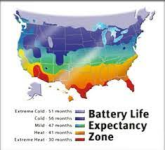Perhaps a desulfator used from the beginning will prevent sulfate buildup on cell plates, but after weeks of testing a desulfator / charger on the two weak 75 ah cells taken out of my Ryobi 480e (replaced all cells with 100 ah) there was zero improvement. I have purchased a lab power supply, and a 12V to 120V inverter to try a different cell refurbishment method. Anyone interested stand by for results over the next few weeks

Keith
PS: Anyone know the CCA rating of new 75 ah Ryobi batteries? My quick test for results is a CCA check (long test is a controlled discharge with the 12V to 120V inverter at a set discharge rate), but I don't know what "good" results would be... I "think" it is in the 300 CCA range but real information would be welcome.
Desulphating will only work if the battery has sulphated
Sulphating happens when the battery has been run down dead flat and let to stand that way for extended time .
When you use a desulphater you generate explosions of gas on the plate surface with knocks the old deactivated paste off allowing the active paste underneath to get reverted to charge the battery
Every time you run one you loose paste thickness and active paste thickness is what determines the Ah of the battery
The thicker the paste the longer it will run, past grain sizes being equal .
Now the caveat to this is PVR SLA AGM batteries.
In these batteries the space between the paste surfaces is occupied by a fiberglass mat .
The purpose of the matt is to support the plate and make it more vibration fatigue resistant because the grids now days are very very thin, typically around 0.75mm to 0.5mm .
in the old days they were 3mm to 2 mm thick which is what made them so heavy, If you are over 40 then you will remember the old days of the 13 plate car bateries that took 2 big beefy blokes to pick up .
Now days the proverbial 40 lb weakling can carry one in each hand without breaking into a sweat.
Now the you-beaut fancy charger can not blow away the sulphated surface of the paste because that sealed battery is pressure valve regulated ( PVR ) to prevent the gassing at the plate that your charger is trying to make happen .
Once a modern battery is dead, then it is dead .
A dumb charger can revive a dead flat battery but not a totally used up deceased battery
Auto chargers can not tell the difference between a dead flat battery & a fully charged battery which is why you need an old fashioned dumb charger and in particular one that uses a stepped transformer where you can adjust both the voltage ( in 2 volt steps ) and amperage .
Expept to pay over $ 1000 for one of them and buy a pocket timmer because they are not called battery cookers for nothing .
And do not bother looking at any "how to regenerate your battery" videos on your tube.
They are all total BS
Some solutions like EDTA or DMG can be use to complex used paste then cause it to precipate down the bottom of the cell , from where it can be washed out, from OPEN CELL batteries not sealed batteries .
The best thing to do is open your wallet & buy a spiral cell battery of which Optima are the most commonly known brand
They are head & shoulders better than flat plate batteries because they have more surface area than a rectangular plate battery and the plates are continious so you get far less internal resistance between the grid & the busbars that take to power to the terminals .
However like everything that is substantially better, they are substantially more expensive


